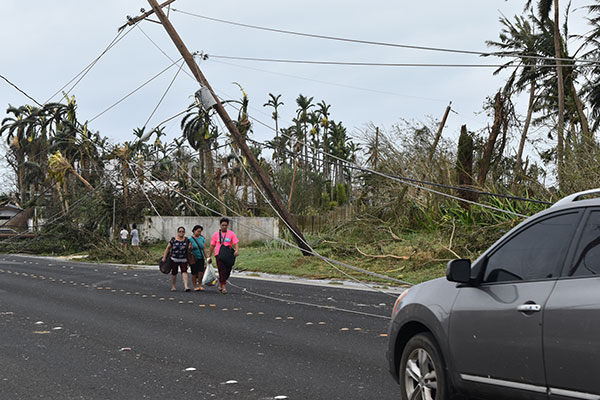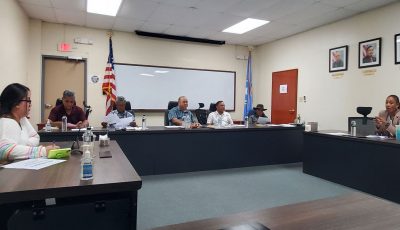TOP STORIES OF THE YEAR

Three individuals walk in the middle of Chalan Monsignor Guerrero Road amidst the destruction brought by Super Typhoon Yutu. (Jon Perez)
1. Typhoons Yutu and Mangkhut
The one-two punch that Super Typhoon Yutu and Typhoon Mangkhut did to the CNMI in the latter part of this year was so devastating, so shattering, and of such magnitude that these twin events alone merit the top six stories of 2018, crowding out many notable events of the year.
Super Typhoon Yutu, a category 5 typhoon, barreled across the CNMI over two months ago. A month prior to Super Typhoon Yutu, Typhoon Mangkhut struck Rota, reportedly the strongest typhoon to make landfall on the island since 2002.
According to the National Weather Service, Super Typhoon Yutu made direct landfall in the CNMI with maximum sustained winds of up to 170 mph and gusts of up to 200 mph.
Rota bore the brunt of Typhoon Mangkhut on Sept. 11, with maximum sustained winds of up to 100 mph and gusts up to 130 mph.
Yutu was comparable to the magnitude of Super Typhoon Jean that left Saipan in shambles in the early 1960s. Typhoon Mangkhut was comparable to the magnitude of Typhoon Pongsona that devastated Rota back in 2002. (Kimberly Bautista)
2. Govt response to Mangkhut, Yutu
The CNMI and federal governments were quick to act on Typhoon Mangkhut and Super Typhoon Yutu, with the local administration, working with the CNMI Office of Homeland Security and Emergency Management and National Weather Service Guam, planning ahead even before both storms slammed into the CNMI in September and October.
Local and federal government, and non-governmental organization personnel—like the Commonwealth Utilities Corp., Department of Fire and Emergency Services, Federal Emergency Management Agency, American Red Cross—were sent to Rota either before the storm or one day after it.
It helped Saipan and Tinian that FEMA and other military personnel were still on Rota even before the mega storm blasted through the islands. It also helped that the administration of Gov. Ralph DLG Torres, who said that Typhoon Soudelor in 2015 taught the Commonwealth a big lesson, asked the White House to declare a state of emergency before the storms arrived separately and a state of disaster after. (Jon Perez)
3. Coordinated response
Drawing on the painful lessons of Typhoon Soudelor in 2015, the CNMI’s immediate response to the destruction of Super Typhoon Yutu involved both government and non-government entities. The U.S. Armed Forces, Federal Emergency Management Agency, and U.S. Small Business Administration swung into action, handing out relief goods, debris cleanup, cash assistance, and temporary shelter aid. The American Red Cross-NMI Chapter distributed hygiene packs along with cash assistance. The Philippine Consulate General in Agana handed out cash to qualified families, while the CNMI Nutritional Assistance Program gave out millions in dollars worth of disaster food stamps. And then there were also scores of non-government services that also gave aid. (Kimberly Bautista)
4Schools incur much damage
Several Public School System campuses sustained damage from Super Typhoon Yutu, including the Francisco M. Sablan Middle School, Hopwood Middle School, Oleai Elementary School, and Marianas High School. The Northern Marianas College also sustained heavy damage, causing it to cancel classes for over a month since the typhoon. Currently, NMC is holding afternoon classes at the Saipan Southern High School and is eyeing to relocate back to its As Terlaje campus early February 2019. (Erwin Encinares)
5. Shelters activated
As early as Oct. 24, 2018, when Super Typhoon Yutu was just projected to pass through Saipan and Tinian, the initial shelters that the Public School System had activated—Marianas High School, Kagman High School, and the Koblerville Elementary School—were already full, with about 226 shelterees.
Two days later, on Oct. 26, 2018, all shelters were at full capacity, with about 840 shelterees. The Commonwealth Office on Transport Authority provided transportation.
Currently, there remains about 136 shelterees at the Kagman Emergency Shelter Facility—the former Juvenile Detention Center in Kagman—which is being eyed as a permanent shelter for future typhoons. (Erwin Encinares)
6. CUC response to Yutu
With Super Typhoon Yutu’s catastrophic devastation of Saipan and Tinian last Oct. 24 and 25 occurring less than two months after Typhoon Mankhut caused a major damage on Rota, the Commonwealth Utilities Corp. management and crew have had perhaps the most difficult and tiring job among first responders.
CUC executive director Gary P. Camacho said the most challenging part in the restoration operations is having enough supply of materials. After all, due to recent wildfires in California and hurricanes in Florida and North Carolina, these areas also need materials and manpower for their recovery.
Last Dec. 20, a total of 17 pallets of materials needed for CUC’s restoration arrived on Saipan.
Recent CUC reports indicated that on Saipan, over 61 percent of customers already have electric power and over 82 percent have water. On Tinian, over 40 percent of customers already have power as restoration there started late. Water production is at 100 percent.
A total of 53 CUC personnel are involved in the operations to provide power and 34 others are on water on Saipan and Tinian.
CUC hopes to have 100 percent power back on the two islands by mid- to end of February.
CUC is finalizing a contract for additional linemen to add to the existing ground labor force to speed up the restoration process.
Three days after Yutu, the CNMI got off-island assistance from the Guam Power Authority.
Last Nov. 3, CUC accepted the offer of linemen assistance by Kosrae, Pohnpei, and Chuuk utilities. CUC was also in coordination with Palau for additional linemen assistance.
A week after Yutu, CUC managed to provide power back to 5 percent of Saipan. CUC then started working to restore power in Lower Base. (Ferdie De La Torre)
7. Torres, Palacios win by a landslide
Gov. Ralph DLG Torres and Senate President Arnold I. Palacios of the Republican Party won the Nov. 13 general election for governor and lieutenant governor, respectively, by a huge margin, over the Democratic Party-backed independent tandem of former governor Juan N. Babauta and former Education Commissioner Dr. Rita A. Sablan.
The election was generally peaceful, but was marred throughout the campaign period by mudslinging in social media.
Several local GOP lawmakers lost their respective bids, but the Republicans still kept their majority hold in the House, winning 13 of 20 seats.
Delegate Gregorio Kilili Sablan (Ind-MP), who sought a sixth term to his position, easily defeated Rep. Angel Demapan of the GOP.
It was the biggest and most difficult election in CNMI history, considering that many areas, including polling places, had no electric power due to Super Typhoon Yutu’s catastrophic destruction on Saipan and Tinian.
In fact, the original schedule of the election day was Nov. 6 and was later moved to Nov. 13. Many doubted whether there would be a good turnout, considering that many houses were destroyed, some roads still had leaning power poles, and debris still littered many villages.
Unlike in previous gubernatorial elections, the 2018 voters did not go back to the polling places again for a runoff election, which was a relief to voters who were still suffering from Yutu’s fury. (Ferdie De La Torre)
8. Marijuana prohibition ends
Sept. 21 was a historic moment for cannabis supporters in the CNMI after Gov. Ralph DLG Torres signed into law a bill that legalized the medicinal and recreational use of marijuana, making the Commonwealth the first U.S. jurisdiction to lift marijuana prohibition through legislation and not by people’s initiative or ballot.
Rep. Joseph P. Deleon Guerrero (R-Saipan) introduced the bill, House Bill 20-178, now known as Public Law 20-66 or the Taulamwaar Sensible CNMI Cannabis Act of 2018. The new law, once the newly-formed CNMI Cannabis Commission comes out with the implementing rules and other guidelines, authorizes regulation and control of cannabis use in the CNMI.
Adults who are over-21 are now legal to possess small amounts of marijuana (one ounce), marijuana-infused products (16 ounces in solid form and 72 ounces in liquid form), and marijuana extracts (five grams). Marijuana use and possession is still illegal until the commission finalizes promulgating the rules that are needed to regulate the new cannabis industry.
The commissioners are Nadine Deleon Guerrero, Matt Deleon Guerrero, Valentino Taisacan Jr., Lawrence Duponcheel, and Thomas Songsong. They are planning to meet January. (Jon Perez)
9. CW Program extension
The CNMI received news on July 25, 2018, that U.S. President Donald Trump had enacted U.S. Rep. Rob Bishop’s (R-UT) H.R. 5956, effectively extending the CW program by 10 calendar years. That program, which was supposed to expire in 2018, allows the CNMI to hire foreigners on the CW-1 visa. Delegate Gregorio Kilili C. Sablan (Ind-MP) co-sponsored the bill. The newly passed law also added 8,001 additional CW-1 slots for fiscal year 2019. (Erwin Encinares)
10. IPI saga
Imperial Pacific International (CNMI) LLC continues to make controversial decisions in connection with the ongoing construction of its hotel and operations of the region’s lone casino. IPI, in the last quarter of the year, laid off over 300 employees—mostly foreign guest workers.
IPI first terminated its agreement with contractor Pacific Rim, then laid off 80 construction workers citing that they are prioritizing U.S. eligible laborers in order to finish the hotel side of Imperial Pacific Resort. The casino has been in full operation at the initial gaming facility for more than a year now.
Then Super Typhoon Yutu struck Saipan in late October, causing the casino’s operations to be suspended for a few days since there were no tourists or other off-island players. They began terminating casino employees after that.
The workers staged a protest in front of the IPI construction site in Garapan where they demanded IPI chief executive officer Mark Brown to meet with them to answer some of their questions. Despite Brown meeting them, the workers were still sent home to their respective countries.
Yutu also caused one of the cranes at the construction site to lean to one side, with businesses near the area showing concern while one of IPI’s yachts ran aground due to strong waves during the storm. (Jon Perez)



























